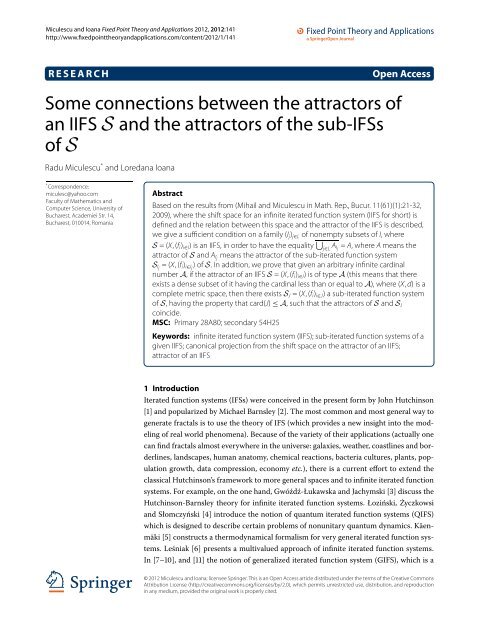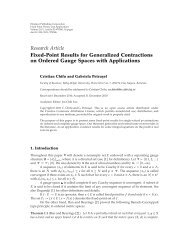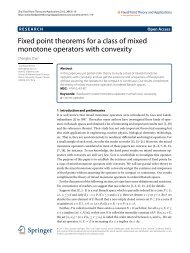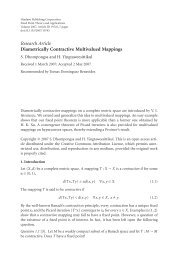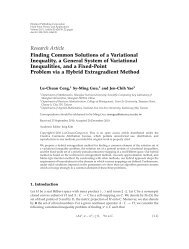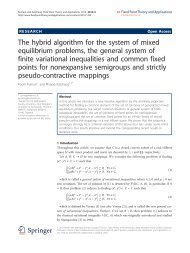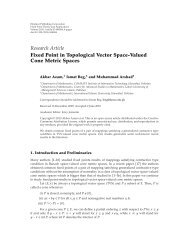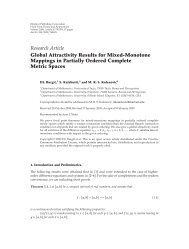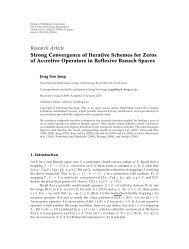Fixed Point Theory and Applications
Fixed Point Theory and Applications
Fixed Point Theory and Applications
You also want an ePaper? Increase the reach of your titles
YUMPU automatically turns print PDFs into web optimized ePapers that Google loves.
Miculescu <strong>and</strong> Ioana <strong>Fixed</strong> <strong>Point</strong> <strong>Theory</strong> <strong>and</strong> <strong>Applications</strong> 2012, 2012:141<br />
http://www.fixedpointtheory<strong>and</strong>applications.com/content/2012/1/141<br />
R E S E A R C H Open Access<br />
Some connections between the attractors of<br />
an IIFS S <strong>and</strong> the attractors of the sub-IFSs<br />
of S<br />
Radu Miculescu * <strong>and</strong> Loredana Ioana<br />
* Correspondence:<br />
miculesc@yahoo.com<br />
Faculty of Mathematics <strong>and</strong><br />
Computer Science, University of<br />
Bucharest, Academiei Str. 14,<br />
Bucharest, 010014, Romania<br />
Abstract<br />
Based on the results from (Mihail <strong>and</strong> Miculescu in Math. Rep., Bucur. 11(61)(1):21-32,<br />
2009), where the shift space for an infinite iterated function system (IIFS for short) is<br />
defined <strong>and</strong> the relation between this space <strong>and</strong> the attractor of the IIFS is described,<br />
we give a sufficient condition on a family (Ij)j∈L of nonempty subsets of I,where<br />
S =(X,(fi)i∈I)isanIIFS,inordertohavetheequality <br />
j∈L<br />
AIj = A,whereAmeans the<br />
attractor of S <strong>and</strong> AIj means the attractor of the sub-iterated function system<br />
SIj =(X,(fi)i∈Ij )ofS. In addition, we prove that given an arbitrary infinite cardinal<br />
number A, if the attractor of an IIFS S =(X,(fi)i∈I) is of type A (this means that there<br />
exists a dense subset of it having the cardinal less than or equal to A), where (X, d)isa<br />
complete metric space, then there exists SJ =(X,(fi)i∈J) a sub-iterated function system<br />
of S, having the property that card(J) ≤ A, such that the attractors of S <strong>and</strong> SJ<br />
coincide.<br />
MSC: Primary 28A80; secondary 54H25<br />
Keywords: infinite iterated function system (IIFS); sub-iterated function systems of a<br />
given IIFS; canonical projection from the shift space on the attractor of an IIFS;<br />
attractor of an IIFS<br />
1 Introduction<br />
Iterated function systems (IFSs) were conceived in the present form by John Hutchinson<br />
[1] <strong>and</strong> popularized by Michael Barnsley [2]. The most common <strong>and</strong> most general way to<br />
generate fractals is to use the theory of IFS (which provides a new insight into the modeling<br />
of real world phenomena). Because of the variety of their applications (actually one<br />
can find fractals almost everywhere in the universe: galaxies, weather, coastlines <strong>and</strong> borderlines,<br />
l<strong>and</strong>scapes, human anatomy, chemical reactions, bacteria cultures, plants, population<br />
growth, data compression, economy etc.), there is a current effort to extend the<br />
classical Hutchinson’s framework to more general spaces <strong>and</strong> to infinite iterated function<br />
systems. For example, on the one h<strong>and</strong>, Gwóźdź-Łukawska <strong>and</strong> Jachymski [3]discussthe<br />
Hutchinson-Barnsley theory for infinite iterated function systems. Łoziński, Życzkowsi<br />
<strong>and</strong> Słomczyński [4] introduce the notion of quantum iterated function systems (QIFS)<br />
which is designed to describe certain problems of nonunitary quantum dynamics. Käenmäki<br />
[5] constructs a thermodynamical formalism for very general iterated function systems.<br />
Leśniak [6] presents a multivalued approach of infinite iterated function systems.<br />
In [7–10], <strong>and</strong> [11] the notion of generalized iterated function system (GIFS), which is a<br />
© 2012 Miculescu <strong>and</strong> Ioana; licensee Springer. This is an Open Access article distributed under the terms of the Creative Commons<br />
Attribution License (http://creativecommons.org/licenses/by/2.0), which permits unrestricted use, distribution, <strong>and</strong> reproduction<br />
in any medium, provided the original work is properly cited.
Miculescu <strong>and</strong> Ioana <strong>Fixed</strong> <strong>Point</strong> <strong>Theory</strong> <strong>and</strong> <strong>Applications</strong> 2012, 2012:141 Page 2 of 11<br />
http://www.fixedpointtheory<strong>and</strong>applications.com/content/2012/1/141<br />
family of functions f1,...,fn : Xm → X, (X, d) beingametricspace<strong>and</strong>m, n ∈ N, isintroduced.<br />
Under certain conditions, the existence of the attractor of such a GIFS is proved<br />
<strong>and</strong> its properties are explored (among them, an upper bound for the Hausdorff-Pompeiu<br />
distance between the attractors of two such GIFSs, an upper bound for the Hausdorff-<br />
Pompeiu distance between the attractors of such a GIFS <strong>and</strong> an arbitrary compact set of<br />
X are presented, <strong>and</strong> its continuous dependence in the fk’s is proved). Moreover, in [12]<br />
<strong>and</strong> [13], the existence of an analogue of Hutchinson’s measure associated to certain GIFSs<br />
with probabilities (GIFSp for short) is proved. Also, we showed that the support of such<br />
a measure is the attractor of the given GIFSp <strong>and</strong> we construct a sequence of measures<br />
converging to this measure. On the other h<strong>and</strong>, in [14], we provided a general framework<br />
where attractors are nonempty closed <strong>and</strong> bounded subsets of topologically complete metric<br />
spaces <strong>and</strong> where the IFSs may be infinite, in contrast to the classical theory (see [2]),<br />
where only attractors that are compact metric spaces <strong>and</strong> IFSs that are finite are considered.<br />
In the paper [15], a generalization of the notion of the shift space associated to an IFS<br />
is presented. More precisely, the shift space for an infinite iterated function system (IIFS)<br />
is defined <strong>and</strong> the relation between this space <strong>and</strong> the attractor of the IIFS is described. A<br />
canonical projection π (which turns out to be continuous) from the shift space of an IIFS<br />
on its attractor is constructed <strong>and</strong> sufficient conditions for this function to be onto are<br />
provided. While it is possible to approximate any compact subset in the space X by an attractor<br />
of some IFS, the question as to which compact can be realized as attractors of IFSs<br />
remains elusive. The attractors of IFSs come in so many different forms that their diversity<br />
never fails to amaze us. The repertory of attractors of IFSs starts with simple spaces<br />
such as an interval, a square, the closure of the unit disc (see [16]) <strong>and</strong> continues with<br />
more exotic sets such as the Cantor ternary set, the Sierpinski gasket, the Menger sponge,<br />
the Black Spleenwort fern, the Barnsley fern, the Castle fractal, the Julia sets of quadratic<br />
transformations (see [2]), the Koch curve, the Polya’s curve, the Levy’s curve or the Takagi<br />
graph (see [17]). Along the same lines, Arenas <strong>and</strong> Sancez Granero [18] proved that every<br />
graph (i.e., a locally connected continuum with a finite number of end points <strong>and</strong> ramification<br />
points) is the attractor of some iterated function system. S<strong>and</strong>ers [19] provedthat<br />
arcs in Rn of finite length are attractors of some IFS on Rn .In[20] Seceleanprovedthat<br />
each compact subset of a metric space can be presented as the attractor of a countable<br />
iterated function system. At the same time, it is a natural question to ask whether it is<br />
true that any compact set is actually the invariant set of some IFS. The answer is negative.<br />
Here are some examples: Kwiecinski [21] constructedalocallyconnectedcontinuumin<br />
the plane which is not an attractor of any iterated function system; Crovisier <strong>and</strong> Rams<br />
[22] constructed an embedded Cantor set in R <strong>and</strong>showedthatitcouldnotberealizedas<br />
an attractor of any iterated function system; Stacho <strong>and</strong> Szabo [23] constructed compact<br />
sets in R that are not invariant sets for any IFS; S<strong>and</strong>ers [19] constructed an n-cell in Rn+1 <strong>and</strong> showed that this n-cell cannot be the attractor of any IFS on Rn+1 for each natural<br />
number n.<br />
In the present paper, using the results from [15], especially Theorem 4.1, we present a<br />
sufficient condition on a family (Ij)j∈L of nonempty subsets of I,whereS =(X,(fi)i∈I)isan<br />
IIFS, in order to have the equality <br />
j∈L AIj = A,whereA means the attractor of S <strong>and</strong> AIj<br />
means the attractor of the sub-iterated function system SIj =(X,(fi)i∈Ij )ofS. In addition,<br />
two examples concerning this result are presented. The first example shows that the above
Miculescu <strong>and</strong> Ioana <strong>Fixed</strong> <strong>Point</strong> <strong>Theory</strong> <strong>and</strong> <strong>Applications</strong> 2012, 2012:141 Page 3 of 11<br />
http://www.fixedpointtheory<strong>and</strong>applications.com/content/2012/1/141<br />
mentioned condition is not necessary, while the second example provides a case for which<br />
it is a necessary condition.<br />
Moreover, we prove that given an arbitrary infinite cardinal number A,iftheattractorof<br />
an IIFS S =(X,(fi)i∈I)isoftypeA,where(X, d) is a complete metric space, then there exists<br />
SJ =(X,(fi)i∈J) a sub-iterated function system of S, havingthepropertythatcard(J) ≤ A,<br />
such that the attractors of S <strong>and</strong> SJ coincide.<br />
2 Preliminaries<br />
For the basic facts concerning infinite iterated function systems (IIFSs) <strong>and</strong> the shift space<br />
associated to an IIFS one can consult [15].<br />
Definition 2.1 Ametricspace(X, d)issaidtobeoftypeA,whereAis a cardinal number,<br />
if there exists a dense subset A of X having the property that card A ≤ A.<br />
Definition 2.2 GivenanIIFSS =(X,(fi)i∈I) <strong>and</strong>asubsetJof I, the IIFS SJ =(X,(fi)i∈J) is<br />
called a sub-iterated function system of S (a sub-IFS of S for short).<br />
The following remark, which actually is Lemma 3.6 from [14], will be extensively used<br />
in this paper (see the proofs of Theorems 3.1 <strong>and</strong> 3.3).<br />
Remark 2.3 Let us consider a complete metric space (X, d), an IIFS S =(X,(fi)i∈I)<strong>and</strong>the<br />
function FS : B∗ (X) → B∗ (X) givenbyFS(B)= <br />
i∈I fi(B), for all B ∈ B∗ (X), where B∗ (X)<br />
denotes the family of nonempty bounded closed subsets of X.<br />
Then there exists a unique A(S) ∈ B∗ (X)suchthat<br />
<br />
FS A(S) = A(S).<br />
Moreover, for T ∈ B ∗ (X), we have<br />
FS(T) ⊆ T ⇒ A(S) ⊆ T.<br />
The following result is used in the proof of Theorem 3.3.<br />
Proposition 2.4 Let S =(X,(fi)i∈I) be an IIFS, where (X, d) is a complete metric space, let<br />
α : ∗ → be an arbitrary function, <strong>and</strong> let us consider the set M = {ωα(ω)|ω ∈ ∗ }.Then<br />
π(M) is dense in A(S).<br />
Proof Let us consider<br />
c := sup Lip(fi)
Miculescu <strong>and</strong> Ioana <strong>Fixed</strong> <strong>Point</strong> <strong>Theory</strong> <strong>and</strong> <strong>Applications</strong> 2012, 2012:141 Page 4 of 11<br />
http://www.fixedpointtheory<strong>and</strong>applications.com/content/2012/1/141<br />
<strong>and</strong><br />
π [ω0]mα <br />
[ω0]m = a[ω0]mα([ω0]m) ∈ A[[ω0]mα([ω0]m)]m = A[ω0]m<br />
(see point 2 of Theorem 4.1 from [15]), we obtain, using point 1 of the same theorem, that<br />
d π(ω0), π [ω0]mα <br />
[ω0]m ≤ diam(A[ω0]m ) ≤ cm diam(A),<br />
for all m ∈ N.<br />
Taking into account the fact that c ∈ [0, 1), it follows that<br />
π() ⊆ π(M),<br />
<strong>and</strong> therefore, using point 6(ii) of Theorem 4.1 from [15], we conclude that<br />
i.e.,<br />
A = π() ⊆ π(M) ⊆ A,<br />
π(M)=A. <br />
3 Themainresults<br />
Theorem 3.1 Let S =(X,(fi)i∈I) be an IIFS, where (X, d) is a complete metric space, A :=<br />
A(S) be its attractor <strong>and</strong> (Ij)j∈L be a family of nonempty subsets of I such that <br />
j∈L Ij = I.<br />
If for every i1 ∈ Ij1 , i2 ∈ Ij2 ,...,in ∈ Ijn ,where{j1, j2,...,jn}⊆L, there exists l ∈ Lsuchthat<br />
i1, i2,...,in ∈ Il,then<br />
<br />
j∈L<br />
where AIj<br />
AIj<br />
= A,<br />
is the attractor of the sub-iterated function system SIj =(X,(fi)i∈Ij ) of S.<br />
Proof Let us note that on the one h<strong>and</strong> we have<br />
<br />
j∈L<br />
AIj<br />
Indeed, since<br />
FSI j (A)= <br />
⊆ A. (∗)<br />
i∈Ij<br />
using Remark 2.3,weget<br />
AIj<br />
⊆ A,<br />
for all j ∈ L, <strong>and</strong> therefore<br />
<br />
⊆ A.<br />
AIj<br />
j∈L<br />
fi(A) ⊆ <br />
fi(A)=FSI (A)=A,<br />
i∈I
Miculescu <strong>and</strong> Ioana <strong>Fixed</strong> <strong>Point</strong> <strong>Theory</strong> <strong>and</strong> <strong>Applications</strong> 2012, 2012:141 Page 5 of 11<br />
http://www.fixedpointtheory<strong>and</strong>applications.com/content/2012/1/141<br />
Taking into account the fact that A is a closed set, we get<br />
<br />
j∈L<br />
AIj<br />
⊆ A.<br />
On the other h<strong>and</strong>, we have<br />
A ⊆ <br />
AIj . (∗∗)<br />
j∈L<br />
Indeed, for an arbitrary ω = i1i2 ···in ∈ ∗ ,since <br />
j∈L Ij = I, thereexistj1, j2,...,jn ∈ L<br />
such that i1 ∈ Ij1 , i2 ∈ Ij2 ,...,in ∈ Ijn , <strong>and</strong>, according to the hypothesis, there exists l ∈ L<br />
such that i1, i2,...,in ∈ Il. Then, using point 5 of Theorem 4.1 from [15], we obtain<br />
eω ∈ AI ⊆ l <br />
AIj .<br />
j∈L<br />
It follows, using again the same point 5 of Theorem 4.1 from [15], that<br />
A = eω|ω ∈ ∗ ⊆ <br />
AIj .<br />
j∈L<br />
From (∗)<strong>and</strong>(∗∗), we obtain that<br />
<br />
j∈L<br />
AIj<br />
= A.<br />
Corollary 3.2 Let S =(X,(fi)i∈I) be an IIFS, where (X, d) is a complete metric space, <strong>and</strong><br />
A := A(S) be its attractor.<br />
Then<br />
<br />
∅=J⊆I<br />
J finite<br />
AJ = A,<br />
where AJ is the attractor of the sub-iterated function system SJ =(X,(fi)i∈J) of S.<br />
The following example shows that the condition ‘for every i1 ∈ Ij1 , i2 ∈ Ij2 ,...,in ∈ Ijn ,<br />
where {j1, j2,...,jn}⊆L,thereexistsl∈Lsuch that i1, i2,...,in ∈ Il’ is not a necessary condition<br />
for the equality <br />
j∈L<br />
AIj = A.<br />
Example Let us consider the IIFS<br />
S = [0, 1], d <br />
,(fc)c∈[0,1] ,<br />
where d is the usual distance on [0, 1] <strong>and</strong> the function fc :[0,1]→ [0, 1] is given by<br />
fc(x)=c,<br />
for each x ∈ [0, 1].
Miculescu <strong>and</strong> Ioana <strong>Fixed</strong> <strong>Point</strong> <strong>Theory</strong> <strong>and</strong> <strong>Applications</strong> 2012, 2012:141 Page 6 of 11<br />
http://www.fixedpointtheory<strong>and</strong>applications.com/content/2012/1/141<br />
Since<br />
[0, 1] = <br />
we infer that<br />
c∈[0,1]<br />
A := A(S)=[0,1]<br />
<strong>and</strong> the equality<br />
<br />
fc [0, 1] = FS [0, 1] ,<br />
<br />
{c} = fc {c} = FS{c} {c}<br />
implies that<br />
{c} = A{c},<br />
where A{c} is the attractor of the sub-iterated function system<br />
S{c} = [0, 1], d , {fc} <br />
of S.<br />
Consequently, on the one h<strong>and</strong>, the equality<br />
A = <br />
c∈[0,1]<br />
A{c},<br />
which is equivalent to [0, 1] = <br />
c∈[0,1] {c}, is valid.<br />
On the other h<strong>and</strong>, the family ({c})c∈[0,1] of nonempty subsets of [0, 1] has the property<br />
that<br />
<br />
{c} = [0, 1],<br />
c∈[0,1]<br />
but does not have the property that for every c1, c2,...,cn ∈ [0, 1] there exists c ∈ [0, 1] such<br />
that c1, c2,...,cn ∈{c}.<br />
We will present now an example for which the condition ‘for every i1 ∈ Ij1 , i2 ∈ Ij2 ,...,in ∈<br />
Ijn ,where{j1, j2,...,jn}⊆L, thereexistsl∈Lsuch that i1, i2,...,in ∈ Il’ is a necessary <strong>and</strong><br />
sufficient condition for the equality <br />
j∈L<br />
AIj = A.<br />
Example Let us consider the IIFS<br />
S = <br />
(I), (Fi)i∈I ,<br />
whose attractor is<br />
(I):=A
Miculescu <strong>and</strong> Ioana <strong>Fixed</strong> <strong>Point</strong> <strong>Theory</strong> <strong>and</strong> <strong>Applications</strong> 2012, 2012:141 Page 7 of 11<br />
http://www.fixedpointtheory<strong>and</strong>applications.com/content/2012/1/141<br />
(see Remark 3.2, (i) from [15]) <strong>and</strong> (Ij)j∈L is a family of nonempty subsets of I such that<br />
<br />
j∈L Ij = I.<br />
Then the attractor of a sub-iterated function system<br />
SJ = <br />
(I), (Fi)i∈J<br />
of S,whereJ ⊆ I,is<br />
(J):=AJ.<br />
We claim that <br />
j∈L AIj = A if <strong>and</strong> only if for every i1 ∈ Ij1 , i2 ∈ Ij2 ,...,in ∈ Ijn ,where<br />
{j1, j2,...,jn}⊆L,thereexistsl ∈ L such that i1, i2,...,in ∈ Il.<br />
Indeed, the above theorem assures us that the implication ‘⇐’ is valid. For the implication<br />
‘⇒’ let us consider i1 ∈ Ij1 , i2 ∈ Ij2 ,...,in ∈ Ijn ,where{j1, j2,...,jn}⊆L.Then<br />
ω def<br />
= i1i2 ···ini1i2 ···in ···i1i2 ···in ···∈(I)=A = <br />
AIj ,<br />
which implies that there exist l ∈ L <strong>and</strong> α = α1α2 ···αn ···∈AI l such that<br />
Thus<br />
i.e.,<br />
d(α, ω)< 1<br />
.<br />
3n+1 α1 = i1, α2 = i2,...,αn = in<br />
{i1, i2,...,in} = {α1, α2,...,αn}⊆Il.<br />
Theorem 3.3 Given an infinite cardinal number A,letS =(X,(fi)i∈I) be an IIFS such that<br />
its attractor A(S) is of type A,where(X, d) is a complete metric space.<br />
Then there exists SJ =(X,(fi)i∈J), a sub-iterated function system of S,suchthat<br />
<strong>and</strong><br />
card(J) ≤ A<br />
A(S)=A(SJ).<br />
Proof Let us consider<br />
PA(I)= J ⊆ I| card(J) ≤ A .<br />
For J ∈ P ∗ A (I):=PA(I)–{∅}, with the notations A := A(S)<strong>and</strong>AJ := A(SJ), where<br />
SJ = <br />
X,(fi)i∈J ,<br />
j∈L
Miculescu <strong>and</strong> Ioana <strong>Fixed</strong> <strong>Point</strong> <strong>Theory</strong> <strong>and</strong> <strong>Applications</strong> 2012, 2012:141 Page 8 of 11<br />
http://www.fixedpointtheory<strong>and</strong>applications.com/content/2012/1/141<br />
we have<br />
FSJ (A)= fi(A) ⊆ <br />
fi(A)=FS(A)=A,<br />
i∈J<br />
i∈I<br />
so using Remark 2.3,weget<br />
AJ ⊆ A,<br />
<strong>and</strong> therefore,<br />
d(AJ, A)=0,<br />
which implies that<br />
h(AJ, A)=d(A, AJ).<br />
Hence<br />
AJ = A if <strong>and</strong> only if d(A, AJ)=0. (∗)<br />
Let us consider<br />
β = inf d(A, AJ)|J ∈ P ∗ A (I) .<br />
We claim that there exists J ∈ P ∗ A (I)suchthat<br />
d(A, AJ)=β. (∗∗)<br />
Indeed, for each n ∈ N there exists Jn ∈ P ∗ A (I)suchthat<br />
Then<br />
<strong>and</strong><br />
1<br />
d(A, AJn ) ≤ β +<br />
n .<br />
J := <br />
FSJn<br />
n∈N<br />
Jn ∈ P ∗ A (I)<br />
<br />
(AJ)= fi(AJ) ⊆ <br />
fi(AJ)=FSJ (AJ)=AJ.<br />
i∈Jn<br />
i∈J<br />
So, using again Remark 2.3,wegetthat<br />
AJn<br />
⊆ AJ,
Miculescu <strong>and</strong> Ioana <strong>Fixed</strong> <strong>Point</strong> <strong>Theory</strong> <strong>and</strong> <strong>Applications</strong> 2012, 2012:141 Page 9 of 11<br />
http://www.fixedpointtheory<strong>and</strong>applications.com/content/2012/1/141<br />
<strong>and</strong> therefore,<br />
1<br />
β ≤ d(A, AJ) ≤ d(A, AJn ) ≤ β +<br />
n ,<br />
for all n ∈ N. The last inequality implies, by letting n to tend to ∞,theequality<br />
d(A, AJ)=β.<br />
Our next claim is that<br />
β =0. (∗∗∗)<br />
Indeed, if we suppose that β > 0, taking into account the previous claim, we can consider<br />
J ∈ P ∗ A (I)suchthat<br />
d(A, AJ)=β.<br />
According to Zorn’s lemma, we can consider a maximal subset C of A having the property<br />
that<br />
d(x, y)> β<br />
4 ,<br />
for every x, y ∈ C, x = y.SinceA is of type A,thereexistsasubsetM of A such that<br />
<strong>and</strong><br />
Thus<br />
M = A<br />
card(M) ≤ A.<br />
<br />
M ∩ B c, β<br />
<br />
= ∅,<br />
8<br />
for every c ∈ C. The function f : C → M, givenbyf (c) =yc, whereyc is a fixed element<br />
of M ∩ B(c, β<br />
8 ), is injective (since, if for c1, c2 ∈ C, c1 = c2, wehavef (c1)=f (c2), then yc1 =<br />
yc2<br />
β<br />
, which implies the contradiction 4 < d(c1,<br />
β<br />
c2) ≤ d(c1, yc1 )+d(yc2 , c2)< 8<br />
consequently,<br />
card(C) ≤ card(M) ≤ A.<br />
Let us consider a fixed element j0 ∈ I.Foreachx ∈ A there exists cx ∈ C such that<br />
d(x, cx) ≤ β<br />
4<br />
+ β<br />
8<br />
= β<br />
4<br />
), <strong>and</strong><br />
(1)
Miculescu <strong>and</strong> Ioana <strong>Fixed</strong> <strong>Point</strong> <strong>Theory</strong> <strong>and</strong> <strong>Applications</strong> 2012, 2012:141 Page 10 of 11<br />
http://www.fixedpointtheory<strong>and</strong>applications.com/content/2012/1/141<br />
(since otherwise d(x, c)> β<br />
,foreachc∈C, which implies that x /∈ C, <strong>and</strong> therefore, C ∪<br />
4<br />
{x}= C <strong>and</strong> d(u, v)> β<br />
for every u, v ∈ C ∪{x}, u = v; this contradicts the fact that C is a<br />
4<br />
maximal subset of A having the property that d(x, y)> β<br />
for every x, y ∈ C, x = y). Taking<br />
4<br />
into account Proposition 2.4 (for the function α : ∗ → given by α(ω ′ )=j0j0 ···j0 ···,<br />
for all ω ′ ∈ ∗ ), there exists ωcx = i1(cx) ···in(cx)(cx) ∈ ∗ such that<br />
d π(ωcx j0j0<br />
β<br />
···j0 ···), cx ≤ . (2)<br />
4<br />
Consequently, using (1)<strong>and</strong>(2), we get<br />
d x, π(ωcx j0j0 ···j0 ···) ≤ β<br />
2 .<br />
Since the set<br />
<strong>and</strong><br />
J0 := <br />
cx,x∈A<br />
i1(cx),...,in(cx)(cx) ∪{j0}∈P ∗ A (I)<br />
π(ωcx j0j0 ···j0 ···) ∈ AJ0<br />
(seepoints4<strong>and</strong>6ofTheorem4.1from[15]), we obtain<br />
β<br />
d(x, AJ0 ) ≤<br />
2 ,<br />
for each x ∈ A, <strong>and</strong> therefore,<br />
β<br />
d(A, AJ0 ) ≤<br />
2 .<br />
This contradicts the definition of β.<br />
From (∗∗)<strong>and</strong>(∗∗∗), we conclude that there exists J ∈ P ∗ A (I)suchthat<br />
d(A, AJ)=0,<br />
<strong>and</strong>, consequently, taking into account (∗), we get<br />
A = AJ. <br />
4 Conclusions<br />
In this paper we presented some connections between the attractors of an IIFS S <strong>and</strong> the<br />
attractors of the sub-IFSs of S. More precisely, we provided a sufficient condition on a<br />
family (Ij)j∈L of nonempty subsets of I, whereS =(X,(fi)i∈I) is an IIFS, in order to have<br />
the equality <br />
j∈L<br />
AIj = A, whereAmeans the attractor of S <strong>and</strong> AIj means the attractor<br />
of the sub-iterated function system SIj =(X,(fi)i∈Ij )ofS. Moreover, we proved that given<br />
an arbitrary infinite cardinal number A, if the attractor of an IIFS S =(X,(fi)i∈I)isoftype<br />
A,where(X, d) is a complete metric space, then there exists SJ =(X,(fi)i∈J), a sub-iterated
Miculescu <strong>and</strong> Ioana <strong>Fixed</strong> <strong>Point</strong> <strong>Theory</strong> <strong>and</strong> <strong>Applications</strong> 2012, 2012:141 Page 11 of 11<br />
http://www.fixedpointtheory<strong>and</strong>applications.com/content/2012/1/141<br />
function system of S, havingthepropertythatcard(J) ≤ A, such that the attractors of S<br />
<strong>and</strong> SJ coincide. Two examples illustrating our results are presented. Let us note that the<br />
proof of Theorem 3.3 is based on Proposition 2.4 (which used Theorem 4.1 from [15]) <strong>and</strong><br />
Zorn’s lemma. Since we think that there exists a proof which does not use Zorn’s lemma,<br />
in a future work we plan to present such a proof based only on Theorem 4.1 from [15].<br />
Competing interests<br />
The authors declare that they have no competing interests.<br />
Authors’ contributions<br />
Both authors contributed equally to the writing of this paper. They read <strong>and</strong> approved the final manuscript.<br />
Acknowledgements<br />
The authors want to thank the referees whose generous <strong>and</strong> valuable remarks <strong>and</strong> comments brought improvements to<br />
the paper <strong>and</strong> enhanced clarity.<br />
Received: 29 March 2012 Accepted: 22 August 2012 Published: 4 September 2012<br />
References<br />
1. Hutchinson, JE: Fractals <strong>and</strong> self similarity. Indiana Univ. Math. J. 30, 713-747 (1981)<br />
2. Barnsley, MF: Fractals Everywhere. Academic Press, Boston (1993)<br />
3. Gwó´zd´z-Łukowska, G, Jachymski, J: The Hutchinson-Barnsley theory for infinite iterated function systems. Bull. Aust.<br />
Math. Soc. 72, 441-454 (2005)<br />
4. Loziński, A, ˙Zyczkowski, K, Słomczyński,W:Quantumiteratedfunctionsystems.Phys.Rev.E68(4), Article ID 046110<br />
(2003)<br />
5. Käenmäki, A: On natural invariant measures on generalised iterated function systems. Ann. Acad. Sci. Fenn., Math. 29,<br />
419-458 (2004)<br />
6. Le´sniak, K: Infinite iterated function systems: a multivalued approach. Bull. Pol. Acad. Sci., Math. 52, 1-8 (2004)<br />
7. Mihail, A, Miculescu, R: <strong>Applications</strong> of fixed point theorems in the theory of generalized IFS. <strong>Fixed</strong> <strong>Point</strong> <strong>Theory</strong> Appl.<br />
2008, Article ID 312876 (2008)<br />
8. Mihail, A, Miculescu, R: Generalized IFSs on noncompact spaces. <strong>Fixed</strong> <strong>Point</strong> <strong>Theory</strong> Appl. 2010, Article ID 584215<br />
(2010)<br />
9. Mihail, A: Recurrent iterated function systems. Rev. Roum. Math. Pures Appl. 53(1), 43-53 (2008)<br />
10. Mihail, A: The shift space of a recurrent iterated function system. Rev. Roum. Math. Pures Appl. 53(4), 339-355 (2008)<br />
11. Mihail, A: The shift space for generalized iterated function systems. An. Univ. Bucur. 58(2), 139-162 (2008)<br />
12. Mihail, A, Miculescu, R: A generalization of the Hutchinson measure. Mediterr. J. Math. 6(2), 203-213 (2009)<br />
13. Mihail, A: The Hutchinson measure for generalized iterated function systems. Rev. Roum. Math. Pures Appl. 54(4),<br />
297-316 (2009)<br />
14. Miculescu, R, Mihail, A: Lipscomb’s space ω A is the attractor of an infinite IFS containing affine transformations of<br />
l 2 (A). Proc. Am. Math. Soc. 136, 587-592 (2008)<br />
15. Mihail, A, Miculescu, R: The shift space for an infinite iterated function system. Math. Rep., Bucur. 11(61)(1), 21-32<br />
(2009)<br />
16. Demir, B, Dzhafarov, V, Koçak, S, Üreyen, M: The circle as an attractor of an iterated function system on the plane.<br />
J. Math. Anal. Appl. 332, 735-740 (2007)<br />
17. Yamaguti, M, Hata, M, Kigami, J: Mathematics of Fractals. Translations of the Mathematical Monographs, vol. 167. Am.<br />
Math. Soc., Providence (1997)<br />
18. Arenas, FG, Sancez Granero, MA: Every graph is a self-similar set. Divulg. Mat. 8, 51-56 (2000)<br />
19. S<strong>and</strong>ers, MJ: An n-cell R n+1 in that is not the attractor of any IFS on R n+1 . Missouri J. Math. Sci. 21, 13-20 (2009)<br />
20. Secelean, NA: Any compact subset of a metric space is the attractor of a CIFS. Bull. Math. Soc. Sci. Math. Roum., Nouv.<br />
Sér 44(92), 237-241 (2001)<br />
21. Kwiecinski, M: A locally connected continuum which is not an IFS attractor. Bull. Pol. Acad. Sci., Math. 47, 128-132<br />
(1999)<br />
22. Crovisier, S, Rams, M: IFS attractors <strong>and</strong> Cantor sets. Topol. Appl. 153, 1849-1859 (2006)<br />
23. Stacho, LL, Szabo, LI: A note on invariants of iterated function systems. Acta Math. Hung. 119, 159-164 (2008)<br />
doi:10.1186/1687-1812-2012-141<br />
Cite this article as: Miculescu <strong>and</strong> Ioana: Some connections between the attractors of an IIFS S <strong>and</strong> the attractors of<br />
the sub-IFSs of S. <strong>Fixed</strong> <strong>Point</strong> <strong>Theory</strong> <strong>and</strong> <strong>Applications</strong> 2012 2012:141.


